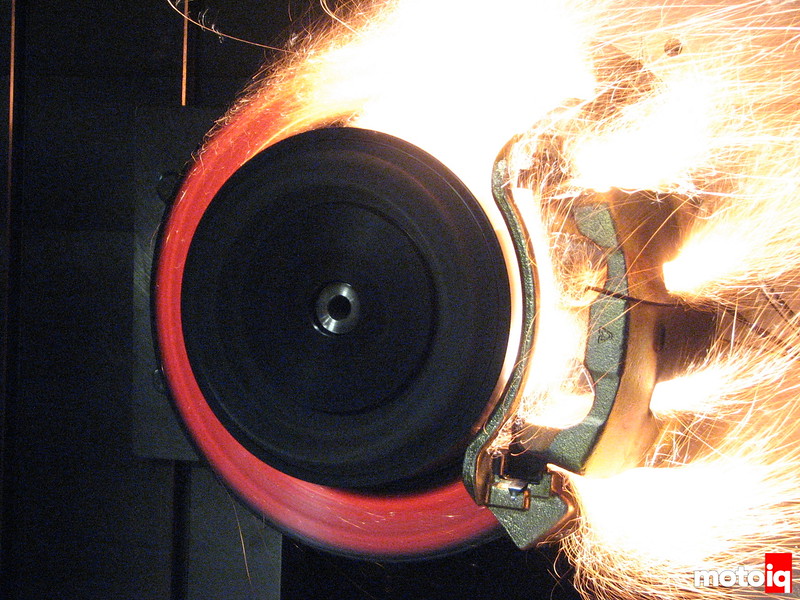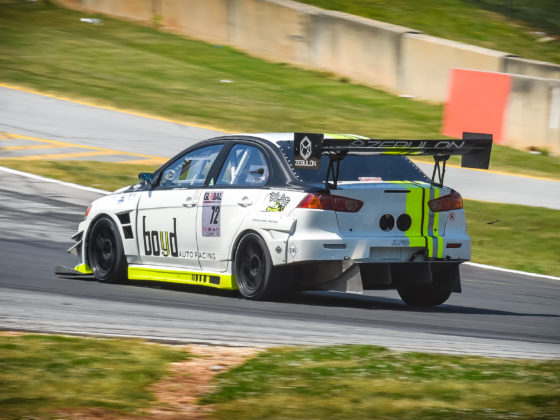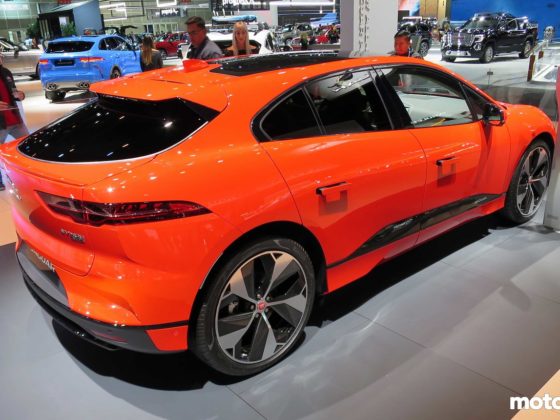
For more extensive dyno testing, like OEM validation for long term wear and noise, StopTech has two very sophisticated validation brake dynos that are also sound proof. They are anechoic chambers where the brake system noise and vibration can be measured.

Airflow over the brake can be controlled to simulate highway or track conditions. Noise and temperature can be accurately measured. To simulate different weight vehicles, the dyno has large flywheels that can be changed out to give the equivalent inertia of different gross vehicle weights.
These dynos can also accommodate an entire corner module, with the upright and the suspension or an entire axle assembly to study what effects they have on brake noise or vibration. They can also help evaluate if countermeasures for noise and/or vibration reduction are effective.
 On the other dyno, we see a performance test for some race compound pads. This is pretty spectacular looking with the glowing hot rotor!
On the other dyno, we see a performance test for some race compound pads. This is pretty spectacular looking with the glowing hot rotor!
 Here we see an all-out stop which is part of a pads test cycle. As you can see, StopTech can do very sophisticated testing of pads, calipers, brake systems and brake interaction with the rest of the car in-house. Not something your usual aftermarket brake company does or has the access to do.
Here we see an all-out stop which is part of a pads test cycle. As you can see, StopTech can do very sophisticated testing of pads, calipers, brake systems and brake interaction with the rest of the car in-house. Not something your usual aftermarket brake company does or has the access to do.
 A truck axle assembly is prepared for testing in one of the large dynos. This is for a noise and vibration test as well as for braking performance and long term pad durability.
A truck axle assembly is prepared for testing in one of the large dynos. This is for a noise and vibration test as well as for braking performance and long term pad durability.




12 comments
That’s really cool how much stuff is in house. Thanks for sharing that; the whole setup is pretty interesting.
As a minor gripe, and this isn’t against Stoptech, I wish there was publicly available comparative data to choose brake parts, and especially pads. Brake dyno results are probably not something the average person could usefully interpret though, much less subtleties of release characteristics and stuff… I just see all sorts of anecdotes where people have success with brand C, H, P, R, etc… and nobody’s really able to quantify anything other than really bad results in a way that doesn’t just boil down to preference.
Stuff like release doesn’t translate too well to measurable testing. It is subjective and figured out by drive evaluation. Usually, stuff like release and gumminess has to do with pad hardness. Softer pads usually don’t release as well. might feel gummier and have better initial bite. Harder pads have better release and sometimes less initial bite. However, this isn’t cut and dry as brake compounding is part art!
As an engineer it just bothers me because seems like it should be possible to get enough data to at least narrow things down. At least PFC and Stoptech have pretty good writeups on their compounds relative to each other, but then you look at Hawk’s product lines where they still sell Black and Blue, or Raybestos where according to some they’re great pads and according to other they’re basically obsolete… much less Pagid and various others.
It almost seems like there should be a flowchart somewhere. “You have such and such brake area, horsepower, grip, etc, start here” followed by things like “I didn’t like this” “OK, try this instead” I realize if I want it I’ll probably have to build it myself though.
Hey Dan, this is exactly what I do for my job. I’m the ENDLESS and PFC distributor for New Zealand, so I go through things like this for my customers.
Dyno data is tricky because it’s only showing the characteristics for one scenario.
Differing input pressures (clamping force), disc speed, slotting and temperature change how each compound will react and perform. Any of the other companies that release their brake data (friction graphs) is only really for comparison against their other compounds, and it’s only a snapshot for those “brake conditions”.
ENDLESS have a friction coefficient range that they release their pads with, but there is no industry standard for friction coefficient testing. For example, ENDLESS ME20 is slightly more bite/friction than Ferodo DS3000. ME20 has a µ of 0.35-0.40 and DS3000 has a µ of around 0.48.
I can understand how it’s so confusing, but I walk my customer’s through these things on a day to day basis.
You can always use the DOT brake pad codes to evaluate a brake pad.
DOT Pad Codes
This two letter edge code mandated by the DOT, and painted on all street legal brake pads, will give you some indication of their ability to resist fade. But only if you know how to read them. However, because of the wide range involved in each letter, it is only a rough indication.
Explanation of D.O.T. Edge Codes Located on all Brake Pads
Official D.O.T. Edge Code
Coefficient of Friction (C.F.)
@ 250 F and @ 600 F
Comments
EE
0.25 to 0.35 both temps
0-25% fade at 600 F possible
FE
0.25 to 0.35 @ 250 F
0.35 to 0.45 @ 600 F
2% to 44% fade at 600 F possible
FF
0.35 to 0.45 both temps
0-22% fade at 600 F possible
GG
0.45 to 0.55
Very Rare
HH
0.55 to 0.65
Carbon/Carbon only.
O.K. up to 3000 F where it glows
Notes: These edge codes are located on the edge of the friction material of every brake pad by government regulation, along with some other codes. The first letter is a grading of the C.F. at 250 F and the second letter is a grading of the material at 600 F. Each letter grade can actually have quite a range of C.F. But a difference in the letter grade from medium to hot temperature could be an indicator of fade. The letters can be in any order. Therefore FE pads fade when hot, and EF pads would not grab when cold.. Also, you should know that Steel on Steel has a C.F. of 0.25!! So EE pads have only marginally more torque than no pads at all! Therefore FF pads are usually considered the minimum for a high-performance pad.
And gumminess is usually attributed to softer pads, because softer pads are in a way more adhesive based. Harder pads are abrasive based. And yes, adhesive is a weird term in general. as it is actuially slight compression in the pad. Should be quantifiable by using a a set pressure and measuring pad height before and after pressure is applied. Can be used to standerdise the stuff, although it’s highly reliant on measure the slightest of difference in height. Once you have that number you can test it with other pads. The more compression, the higher the stick and the more pads wear. The less compression, the more initial bite, the less the pads wear.
You would be a good resource for us too!
I’ve always loved MotoIQ, it’s one of the only websites I can find with new technical information as items are released. More than happy to help wherever I can Mike – feel free to email me.
One thing I’d love to see is upgraded calipers that don’t require a larger wheel to be installed. Those of with WRX’s want a bolt on package that doesn’t require moving up to 18″ wheels. Why is this so hard to get? Is it something that StopTech can make for me if I call them?
This is typically so hard to get because when you are upgrading brakes there are some varying objectives.
1. Increase thermal capacity – Application: Longer time on track without damage to rotors or over-heating brake system. This requires more mass in the rotor, or different material. Maybe small gains in cooling fins built into the rotor itself.
2. Decrease Weight – Milled and channeled Brake calipers, Aluminum floating rotor hats, Carbon Ceramic rotors.
3. Decrease Stopping Distance
For Objective 3, you really have a number of ways of going about it. You can, change your brake pads. A more aggressive compound will brake harder, at the cost of going through more pad material and rotors faster. You could get new brake calipers, something fancy with more pistons and so on. But here’s the thing, can you brake hard enough to lock up your front tires? If you are on a sticky enough of a tire, the answer is ‘not really no’, then maybe you do need more brake force, can it be solved with a pad compound change? If all this extra braking force now required, and stickier tires now means you are putting more heat into the brakes (which otherwise would just be put into rubber smears on the pavement). How much thermal overhead do these factory brakes really have?
Increasing the number of pistons in a brake system does not necessarily increase the clamping force, as it will also require that force to be applied through your brake cylinder, you could change the cly to increase the pedal ratio, but then it changes your pedal feel, and so on and so forth.
There are advantages to the calipers offered by Stoptech and many others that are not found in OE brakes. Thermal barriers to keep heat out of the brake fluid, Multi-piston apposed to sliding single piston calipers, more distributed clamping to even pad wear, lighter weight, more exotic materials. Bling factor, pad selection. But it is very difficult to only try to ‘solve’ one brake problem at a time.
No doubt if you really want you could get a brake solution to fit inside a 17 inch wheel, it may come with greater friction and clamping force than what you could accomplish with new pads in the factory calipers. However, do you really find that you have more tire than brake? Do you think that if you have that much tire you won’t need more thermal capacity in your brakes to keep them from overheating, cracking, or boiling fluid?
Don’t forget about increasing pad volume for life and fade resistance potential.
Great points all around. I’m more interested in switching caliper types. The WRX comes with your standard OEM sliding style caliper, which tend to bind up over time, especially in the salt belt. Moving to a different type eliminates a lot of the bind issues, plus the ability to swap pads without ripping the caliper apart.